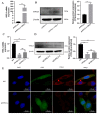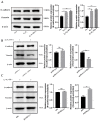YPEL3 Negatively Regulates Endometrial Function via the Wnt/β-Catenin Pathways during Early Pregnancy in Goats
- PMID: 36359097
- PMCID: PMC9656084
- DOI: 10.3390/ani12212973
YPEL3 Negatively Regulates Endometrial Function via the Wnt/β-Catenin Pathways during Early Pregnancy in Goats
Abstract
In ruminants, the establishment of pregnancy requires a series of structural and functional changes in the endometrium under the action of hormones, thereby providing an optimal environment for the implantation of the embryo. In this study, we explored the molecular mechanism by which YPEL3 regulates endometrial function during gestation in goats. We found YPEL3 expression was significantly downregulated during early gestation and that YPEL3 overexpression inhibited the expression of ISG15, but had no significant effects on the expression of RSAD2 and CXCL10 in goat endometrial epithelial cells (gEECs). In addition, YPEL3 silencing significantly inhibited PGF2α secretion and the expression of the prostaglandin synthesis-related rate-limiting enzyme-encoding genes PGFS and PTGES, with no significant effect on the expression of PTGS1 and PTGS2. Moreover, YPEL3 inhibited the expression of vimentin and β-catenin and pretreatment of gEECs with the β-catenin activator CHIR99021 prevented a YPEL3-induced decrease in vimentin expression. Collectively, our findings confirm that, as a hormone-regulated factor, YPEL3 regulates endometrial function by inhibiting the Wnt/β-catenin signaling pathway and provide new insights for further clarification of the mechanism by which YPEL3 functions during early pregnancy in ruminants.
Keywords: Wnt/β-catenin; YPEL3; endometrial function; goat endometrial epithelial cells; hormone.
Conflict of interest statement
The authors declare that they have no conflict of interest.
Figures






Similar articles
-
YPEL3 suppresses epithelial-mesenchymal transition and metastasis of nasopharyngeal carcinoma cells through the Wnt/β-catenin signaling pathway.J Exp Clin Cancer Res. 2016 Jul 11;35(1):109. doi: 10.1186/s13046-016-0384-1. J Exp Clin Cancer Res. 2016. PMID: 27400785 Free PMC article.
-
LncRNA STAT3-AS regulates endometrial receptivity via the STAT3 signaling pathway.Theriogenology. 2024 Mar 1;216:118-126. doi: 10.1016/j.theriogenology.2023.12.032. Epub 2023 Dec 29. Theriogenology. 2024. PMID: 38171198
-
Interferon-τ -induced ISG15-AS regulates endometrial receptivity during early goat pregnancy.Theriogenology. 2023 Mar 15;199:1-10. doi: 10.1016/j.theriogenology.2023.01.008. Epub 2023 Jan 10. Theriogenology. 2023. PMID: 36731281
-
Increased Expression of the YPEL3 Gene in Human Colonic Adenocarcinoma Tissue and the Effects on Proliferation, Migration, and Invasion of Colonic Adenocarcinoma Cells In Vitro via the Wnt/b-Catenin Signaling Pathway.Med Sci Monit. 2018 Jul 10;24:4767-4775. doi: 10.12659/MSM.908173. Med Sci Monit. 2018. PMID: 29988027 Free PMC article.
-
Interaction between sex hormones and WNT/β-catenin signal transduction in endometrial physiology and disease.Mol Cell Endocrinol. 2012 Jul 25;358(2):176-84. doi: 10.1016/j.mce.2011.06.010. Epub 2011 Jun 22. Mol Cell Endocrinol. 2012. PMID: 21722706 Review.
Cited by
-
MEOX1-mediated transcriptional regulation of circABHD3 exacerbates hepatic fibrosis through promoting m6A/YTHDF2-dependent YPEL3 mRNA decay to activate β-catenin signaling.PLoS Genet. 2025 Mar 18;21(3):e1011622. doi: 10.1371/journal.pgen.1011622. eCollection 2025 Mar. PLoS Genet. 2025. PMID: 40100806 Free PMC article.
References
Grants and funding
LinkOut - more resources
Full Text Sources
Research Materials
Miscellaneous

